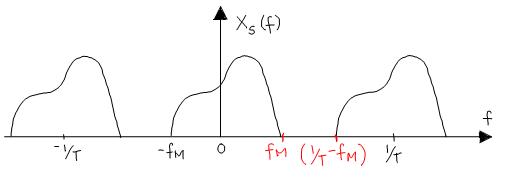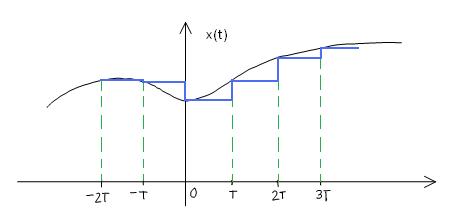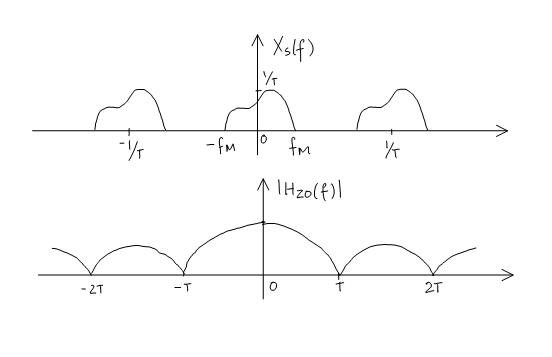LECTURE on September 11, 2009
The perfect reconstruction of $ {x(t)}\,\! $ from $ x_s(t)\,\! $ is possible if $ X(f) = 0\,\! $ when $ |f| \ge \frac{1}{|2T|} $
PROOF: Look at the graph of $ X_s(f)\,\! $
To avoid aliasing,
$ \frac{1}{T}\ - f_M \ge f_M $ $ \quad\iff\quad $ $ \frac{1}{T}\ \ge 2f_M $
To recover the signal, we will require a low pass filter with gain $ T\,\! $ and cutoff, $ \frac{1}{2T} $
Let $ x_r(t)\,\! $ be the reconstructed signal. Then,
$ X_(f) = H_r(f) X_s(f)\,\! $
where,
$ H_r(f) = T rect(f)\,\! $
So,
$ \begin{align} x_r(t) &= h_r(t) * {\color{OliveGreen} X_s(t)} \\ &= sinc \left (\frac{t}{T}\right) * {\color{Blue} \sum_k X(kT) \delta(t-kT)} \\ &= \sum_k X(kT) sinc \left (\frac{t}{T}\right) * \delta(t-kT) \\ &= \sum_k X(kT) sinc \left (\frac{t - kT}{T}\right)\\ \end{align} $
Recall, $ \quad sinc(x) = 0 \quad \iff \quad x = \pm 1, \pm 2, \pm 3 ... \,\! $
At all integer multiples of T,
$ x_r(nT) = X(nT)\,\! $
If Nyquist is satisfied, $ \quad x_r(nT) = X(nT)\quad \forall \quad 't'\,\! $
Contrast this reconstruction with the zero-order hold,
$ \qquad \Rightarrow piecewise\ construct\ approximation\ $
$ \begin{align} x_r(t) &= \sum_k x(kT)\ rect \left (\frac{t - \tfrac {T}{2} - kT}{T}\right) \\ &= \sum_k x(kT)\ rect \left (\frac{t - \tfrac {T}{2} }{T}\right) * \delta (t - kT)\\ &= rect \left (\frac{t - \tfrac {T}{2} }{T}\right) * \sum_k x(kT)\ \delta (t - kT) \qquad and\ if\ we\ look\ clearly,\ \\ &= rect \left (\frac{t - \tfrac {T}{2} }{T}\right) * {\color{Blue}\sum_k x(kT)\ \delta (t - kT)} \\ &= rect \left (\frac{t - \tfrac {T}{2} }{T}\right) * {\color{OliveGreen} X_s(t)}\\ \end{align} $
In the frequency domain,
$ X_r(f) = S_s(f) H_{zo}(f) \qquad ; \qquad H_{zo}(f) = T sinc (Tf) e^{ (-j2 \pi fT/T) } $
So even though $ x_r(t)\,\! $ is not band limited, its higher frequency components are attenuated because the $ |H_{zo}(f)|\ \,\! $ decreases as $ |f| $ increases.






